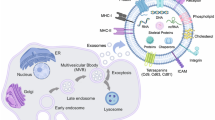Abstract
Purpose. The goal of this study was to investigate the feasibility of utilizing epidermal growth factor (EGF) receptor-mediated endocytosis to enhance cellular uptake and targeting of oligonucleotides in epithelial cancer cells. To overcome the problem of endosomal entrappment associated with receptor-mediated delivery, we also examined the effects of two fusogenic peptides, polymyxin B and influenza HA2 peptide, for their capability to promote cytoplasmic delivery of oligonucleotides.
Methods. A molecular conjugate consisting of EGF and poly-L-lysine (PL) was synthesized and complexed with 5′ fluorescently-labeled oligonucleotide. Cellular uptake of the complex in presence or absence of the fusogenic peptides was monitored fluorometrically. Microscopic studies were performed to visualize the intracellular distribution of the oligonucleotide.
Results. Cells treated with the complex exhibited intracellular fluorescence intensity significantly enhanced over free oligonucleotide-treated controls. The uptake of the complex was shown to occur via the EGF receptor-mediated pathway. Fluorescence microscopic studies revealed cellular internalization of the complex, however, the complex appeared to be accumulated in endocytic vesicles. Exposure of the cells to complex in presence of HA2 peptide and polymyxin B resulted in a more diffused intracellular fluorescence pattern and a corresponding increase in fluorescence intensity. These results are consistent with the known fusion and destabilizing activities of the peptides.
Conclusions. Since EGF receptors are overexpressed in many cancer cell types, the EGF-PL conjugate may potentially be used as an effective and selective delivery system to enhance uptake of oligonucleotides into cancer cells.
Similar content being viewed by others
REFERENCES
J.P. Leonetti, G. Degols, and B. Lebleu. Biological activity of oligonucleotide-poly(L-lysine) conjugates: Mechanism of cell uptake. Bioconj. Chem. 1:149–153 (1990).
R.L. Letsinger, G.R. Zhang, D.K. Sun, T. Ikeuchi, and P. Sarin. Cholesteryl-conjugated oligonucleotides: Synthesis, properties, and activity as inhibitors of replication of human immunodeficiency virus in cell culture. Proc. Natl. Acad. Sci. USA. 86:6553–6556 (1989).
J. Haensler and F.C. Szoka. Polyamidoamine cascade polymers mediate efficient transfection of cells in culture. Bioconj. Chem. 4:372–379 (1993).
J.P. Leonetti, P. Machy, G. Degols, B. Lebleu, and L. Leserman. Antibody-targeted liposomes containing oligodeoxynucleotides complementary to viral RNA selectively inhibit viral replication. Proc. Natl. Acad. Sci. USA. 87:2448–2451 (1990).
G. Citro, C. Scczylik, P. Ginobbi, G. Zupi, and B. Calabretts. Inhibition of leukaemia cell proliferation by folic acid-polylysine-mediated introduction of c-myb antisense oligonucleotides into HL-60 cells. Br. J. Cancer. 69:463–467 (1994).
E. Wagner, D. Curiel, and M. Cotten. Delivery of drugs, proteins, and genes into cells using transferrin as a ligand for receptor-mediated endocytosis. Adv. Drug Del. Rev. 4:113–135 (1994).
T.A. Libermann, H.R. Nusbaum, N. Razon, R. Kris, I. Lax, H. Soreq, N. Whittle, M.D. Waterfield, A. Ullrich, and J. Schlessinger. Amplification, enhanced expression and possible rear-rangement of the EGF receptor gene in primary human tumors of glial origin. Nature. 313:144–147 (1985).
D.J. Slamon, W. Godolphin, L.A. Jones, J.A. Holt, S.G. Wong, D.E. Keith, W.J. Levin, S.G. Stuart, J. Udove, A. Ullrich, and M.F. Press. Studies of the HER-2/neu protooncogene in human breast and ovarian cancer. Science. 244:707–712 (1989).
J.P. Bongartz, A.M. Aubertin, P.G. Mihaud, and B. Lebleu. Improved biological activity of antisense oligonucleotides conjugated to a fusogenic peptide. Nucl. Acid Res. 22:4681–4688 (1994).
J. Carsson, H. Drevin, and R. Axen. Protein thiolation and reversible protein-protein conjugate. Biochem. J. 173:723–737 (1978).
D.C. Wiley and J.J. Skehel. The structure and function of the hemagglutinin membrane glycoprotein of influenza virus. Ann. Rev. Biochem. 56:365–394 (1987).
C.M. Carr and P.S. Kim. A spring-loaded mechanism for the conformational change of influenza hemagglutinin. Cell. 73:823–832 (1993).
A. Gad. Cationic polypeptide-induced fusion of acidic liposomes. Biochim. Biophys. Acta. 728:377–382 (1983).
Author information
Authors and Affiliations
Rights and permissions
About this article
Cite this article
Deshpande, D., Toledo-Velasquez, D., Thakkar, D. et al. Enhanced Cellular Uptake of Oligonucleotides by EGF Receptor-Mediated Endocytosis in A549 Cells. Pharm Res 13, 57–61 (1996). https://doi.org/10.1023/A:1016073132320
Issue Date:
DOI: https://doi.org/10.1023/A:1016073132320




